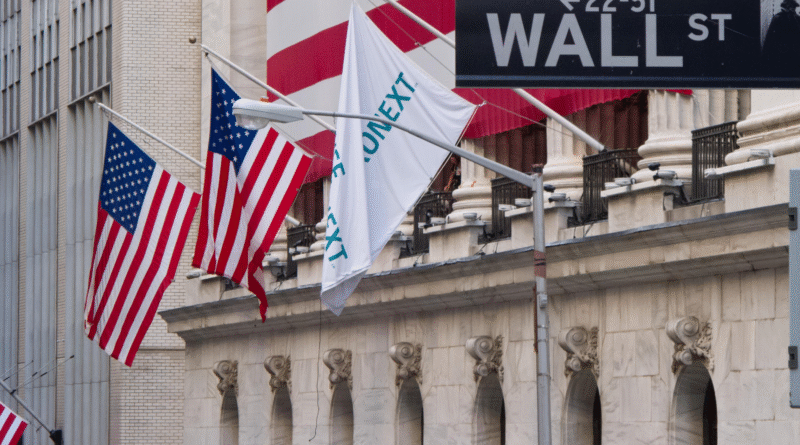Wall Street AI Slumps: Nasdaq Drops 3% in Investor Jitters
Investors on Wall Street are showing signs of waning confidence in artificial intelligence, as evidenced by a sharp decline in tech stocks this week. The Nasdaq Composite Index dropped 3%, marking its worst performance since President Donald Trump’s tariff announcements earlier this year. This Wall Street AI skepticism comes amid broader economic challenges, including a government shutdown and rising layoffs, raising questions about the sustainability of the AI boom.
Tech giants that have driven much of the market’s growth in 2025 saw significant hits. Palantir’s shares fell 11%, Oracle dropped 9%, and Nvidia lost 7%, despite strong earnings reports. Even Meta and Microsoft, which reaffirmed heavy AI spending, saw their stocks dip by about 4%. This follows Palantir’s recent earnings beat that couldn’t prevent a broader sector slump.
Why Wall Street AI Confidence Is Waning
Experts point to stretched valuations as a key factor in this Wall Street AI pullback. Jack Ablin from Cresset Capital noted to The Wall Street Journal that even minor negative news amplifies sell-offs, while positive developments fail to impress given high expectations. The AI sector has seen explosive growth, but investors now demand concrete returns to justify the premiums.
The ongoing government shutdown exacerbates these concerns. Federal operations are halted, affecting everything from regulatory approvals to economic data releases. Consumer sentiment is declining, and widespread layoffs— the worst October in 22 years—add to the uncertainty. This mirrors the recent surge in layoffs that signals deeper economic woes.
While the S&P 500 and Dow Jones fell less severely at 1.6% and 1.2%, the tech-heavy Nasdaq’s drop underscores Wall Street AI vulnerabilities. Broader market factors like inflation fears and geopolitical tensions, including the US-China AI race, are also at play. Nvidia’s CEO recently warned that China could dominate AI, heightening competitive risks for US firms.
Impact on Key Players
Nvidia, often seen as the bellwether for Wall Street AI investments, has been a standout performer in 2025 but couldn’t escape this week’s rout. Its chips power much of the AI infrastructure, yet investors worry about overcapacity and slowing demand. Similarly, Palantir’s government contracts provide stability, but commercial AI adoption lags.
Microsoft and Meta continue pouring billions into AI, with Azure and Llama models leading the charge. However, their post-earnings dips suggest Wall Street AI enthusiasm is cooling. Analysts like those at Reuters highlight that while cloud revenue surges, profitability remains elusive due to massive capital expenditures.
This Wall Street AI shift isn’t isolated. It ties into the intensifying US-China AI competition, where export controls and tariffs could hamper growth. Trump’s policies, including recent tariff hikes, add layers of uncertainty for global supply chains essential to AI hardware.
Broader Economic Context
The government shutdown, now in its second month, disrupts more than just federal paychecks. It delays infrastructure projects vital for data centers, a cornerstone of Wall Street AI infrastructure. Economic adviser Kevin Hassett warned of a softening labor market, with travel and construction sectors hit hardest. This shutdown’s 38-day duration echoes the 2018-2019 crisis but in a more volatile environment.
Consumer confidence surveys show pessimism not seen since 2022, with small businesses delaying hires and payments. Wall Street AI stocks, sensitive to economic cycles, amplify these trends. The Federal Reserve’s cautious stance on rate cuts—amid inflation risks flagged by Ray Dalio—further pressures growth-oriented tech.
Historical precedents offer perspective. The dot-com bust in 2000 saw similar hype around internet tech deflate when earnings disappointed. Today’s Wall Street AI bubble draws parallels, with Michael Burry warning of a $1 billion overvaluation in Nvidia and Palantir. Yet, unlike 2000, AI’s real-world applications in healthcare and automation provide a stronger foundation.
Expert Opinions on Wall Street AI Future
Analysts remain divided. Bullish voices, like those at Goldman Sachs, argue AI will transform productivity, citing 2-3x gains in lean firms per recent studies. They point to OpenAI’s $20 billion revenue run rate as proof of monetization potential. However, bears like Ablin emphasize that without clearer paths to profitability, Wall Street AI will face more volatility.
Industry insiders at TechCrunch events stress diversification. Startups lure talent without big tech budgets by focusing on AI niches like edge computing. Venture capitalists warn against over-reliance on hype, echoing Burry’s bets against AI overvaluation.
Stakeholders vary: Employees at AI firms face job insecurity amid layoffs, while customers benefit from innovations but worry about costs. Regulators push for ethical AI, potentially slowing deployment. For everyday investors, this Wall Street AI dip presents buying opportunities if fundamentals hold.
Comparative Analysis with Past Tech Cycles
Comparing to the 2010s cloud boom, AI’s trajectory is faster but riskier. Cloud adoption was gradual; AI demands upfront trillions in infrastructure. OpenAI’s $1.4 trillion commitments over eight years dwarf Amazon’s AWS buildout. Yet, unlike cloud, AI’s energy demands—equivalent to powering small countries—pose sustainability challenges.
In semiconductors, the Chips Act aimed to bolster US leadership, but expansions for data centers face hurdles. OpenAI lobbied for tax credits, but CEO Sam Altman rejected government bailouts, insisting on market-driven growth. This self-reliance could either innovate or strain resources in a tight funding environment.
Policy comparisons highlight contrasts. Biden’s AI executive order focused on safety; Trump’s tariffs prioritize domestic production. Wall Street AI investors must navigate this shift, as trade wars could raise chip costs by 20-30%.
Stakeholder Perspectives
From customers: AI enhances tools like ChatGPT, but deepfakes erode trust, as seen in Berkshire’s warnings. Fans of Meta and Microsoft praise integrations, yet privacy concerns linger. Affected workers in tech layoffs—over 100,000 this year—question AI’s job creation promises.
Voters and officials weigh in too. During elections, AI’s role in misinformation drew scrutiny. Economists like Hassett urge swift shutdown resolutions to unlock AI-driven growth. For communities, AI hubs in California and Texas promise jobs but strain local grids.
Background on players: Nvidia’s Jensen Huang built an empire on GPUs; Palantir’s Alex Karp leverages defense ties. Microsoft’s Satya Nadella pivots from software to AI services. Their successes fuel Wall Street AI, but personal stakes— like Musk’s rejected pay packages—add drama.
Future Implications for Wall Street AI
What happens next? If the shutdown ends soon, expect a rebound as pent-up demand releases. Fed rate cuts in 2026 could lower borrowing costs for AI capex. Watch for Q4 earnings: If AI ROI materializes, confidence returns; otherwise, more corrections.
Practical lessons: Diversify beyond Wall Street AI—consider bonds or value stocks. Monitor metrics like AI adoption rates and energy efficiency. For investors, dollar-cost averaging mitigates volatility. Long-term, AI could add $15 trillion to global GDP by 2030, per PwC.
This Wall Street AI episode signals maturation. Hype gives way to reality, weeding out weak players. Strong firms like Nvidia will thrive, but expect consolidation. Broader implications include ethical AI governance and equitable benefits distribution.
Recent stock market selloffs like the Dow’s 500-point drop highlight interconnected risks. Yet, opportunities abound for patient investors.
What to Watch For
Key indicators: Semiconductor sales, AI patent filings, and venture funding flows. Geopolitical moves, like Taiwan tensions, could spike chip prices. Regulatory clarity on AI ethics will boost or burden stocks.
For readers: Assess your portfolio’s AI exposure. If overweight, rebalance. Educate on risks—Wall Street AI isn’t a sure bet. Stay informed via reliable sources to navigate this evolving landscape.
As Wall Street AI evolves, balance excitement with caution. The technology promises revolution, but markets demand proof. This week’s slump may be a blip or harbinger; time will tell.
For those exploring investments, understanding stock market basics remains essential. Beginners can start with index funds to gain exposure without picking winners in volatile sectors like AI.
Diversification is key. Consider saving vs investing strategies to build resilience. ESG factors also matter, as sustainable AI practices could differentiate leaders.
Finally, learn from icons like Warren Buffett. His calm in volatility, via timeless secrets, applies to Wall Street AI turbulence. Patience and fundamentals win out.
Source: TechCrunch




